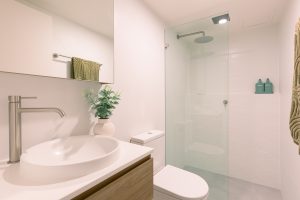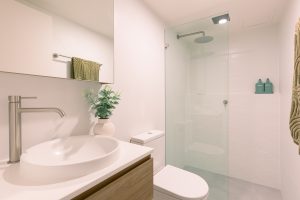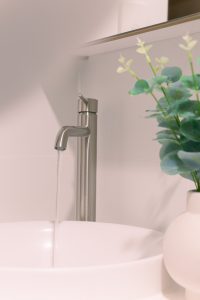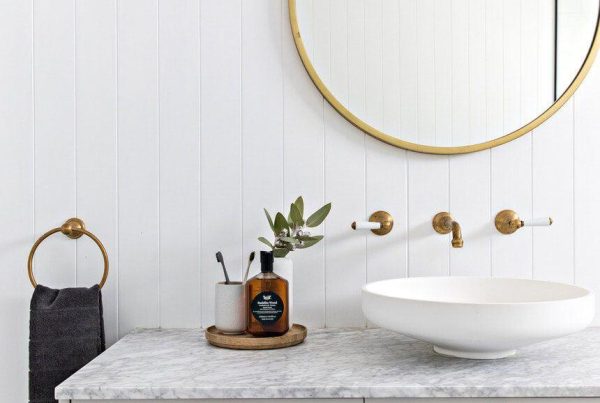What colors make a small bathroom look bigger?
 Small restrooms are common. Few of us have a large bathroom, so we look for ways to tidy it up and make it look bigger.
Small restrooms are common. Few of us have a large bathroom, so we look for ways to tidy it up and make it look bigger.
Everyone has “that” bathroom, which is functional but drab. Some folks can take out a wall or build an addition, but most of us need more realistic options.
Small bathrooms require more than paint or new fixtures. Many design tips and tactics can make a small, drab bathroom look bigger.
-
Color-coordinate
What colors make a bathroom bigger? Light colors like white, cream, pastel blue, grey, or yellow optically extend a room, whereas dark hues like deep red, green, or brown shrink it. Light colors, especially white, reflect light, whereas dark hues absorb light and make the bathroom feel smaller.
You can add pops of color and contrasts with items like linens, artwork, little furniture, and plants. Light colors produce a long-lasting, room-expanding background that you may use for years while making color and style changes elsewhere, avoiding the labor-intensive chore of emptying and repainting the room as regularly.
Pick a single wall and paint it a strong or bright color, or add decorations and shelving to it. The accent wall should not have a door, window, mirror, towel rack, or other useful hardware.
Designers advise against combining dark walls with light floors or vice versa because it segments or chops up the space rather than creating a smooth flow. Painting the ceiling the same color as the floors and walls can also help. More intersecting lines and planes make a room feel smaller and divided.
-
Use paint, texture, and pattern
 Despite strong planning and technique, many creative people are unhappy with their paint jobs. Not everyone studies color, texture, and pattern combinations and how the eye reacts.
Despite strong planning and technique, many creative people are unhappy with their paint jobs. Not everyone studies color, texture, and pattern combinations and how the eye reacts.
Even masters of all these elements may spend hours analyzing light’s illusions and effects. It’s a well-known fact that a room’s color, texture, and pattern or design affect its overall look and feel.
Patterned wallpaper may seem like the way to go in a small bathroom, but a smooth, one-toned color creates a larger wall and floor spread. Patterned paint or wallpaper creates an impression of clutter and crowdedness, while clean, non-patterned, non-textured paint or tile makes a bathroom look bigger.
-
Tile
Tile has been used in wet regions for hundreds of years because it resists moisture and offers unlimited design and color options. It’s the appropriate non-porous material for a bathroom, where moisture can cause mold and mildew. Using a tiny tile in a small bathroom seems logical. This technique’s grout lines make the bathroom appear smaller.
 Small black-and-white checks such as tile, dark hues, and designs that produce extra grout lines can make a busy-looking floor or wall. Large, plain-colored tiles without complex cuts or forms offer a simple, down-the-line style.
Small black-and-white checks such as tile, dark hues, and designs that produce extra grout lines can make a busy-looking floor or wall. Large, plain-colored tiles without complex cuts or forms offer a simple, down-the-line style.
Small bathroom tile and paint design elements are similar. White-beige-yellow, light blue, and grey pastels. Tile can also create a stunning accent wall in the bathroom or shower. Small showers with colored-tile walls and clear-glass doors provide depth.
A tiled shower or shower/tub combination can include built-in, recessed cubbyholes and nooks to store bathing goods. Some people consider this a high priority so they can get rid of gadgets meant to enhance storage in small bathrooms, such as suction-cup baskets or showerhead hooks and caddies.
Bathroom tile can go anywhere: Sink backsplash, floor, shower, and tub surround. Some builders and contractors stop the tile an inch or more short of the ceiling and cap it with molding, but placing the tile all the way to the ceiling or up to a window sill is another architectural tip to minimize lines that split the area. Some individuals use the same tile for the floor and walls to make a room look bigger.
-
Wall-mount basin and toilet

Wall-mounted sinks and toilets don’t need a pedestal or cabinet to cover plumbing pipes, creating a clean aesthetic. This investment would free up bathroom floor space by removing the toilet base and sink pedestal.
Some call the wall-mounted models the float or hover effect since the toilet or sink stands floating over the floor without typical supports. You can save room by replacing a bulky vanity with a pedestal sink, which has a single, slim column for support and piping.
The light color rule applies to toilets, tubs, shower stalls, sinks, and vanities, however, most people replace the toilet more often. Toilets age, break and evolve technologically and for design.
85% of toilets bought are white or off-white, yet they come in numerous hues. People feel white is cleaner, according to a study.
- Know where to place your Shower
In a three-quarter bath with a shower only, enclosure solutions can improve crowded situations literally and visually. Quadrant shower enclosures have inward-swinging, form-fitting doors. Others glide back and forth, which saves room by eliminating outward-swinging doors. Shower enclosures are elegant.
Some individuals desire both a tub and a shower, so combine them and add a highlight to the shower wall, such as a dazzling color on one or two walls and a clear glass enclosure or shower curtain. Different-sized bathtubs save space in compact bathrooms.
- Elevate the storage

Like wall-mounted toilets and sinks, wall-mounted shelves and rails save space and provide a greater look. You can accessorize with colors or textures, or choose glass or clear for clean lines. Clean, continuous lines and reorganizing will assist eliminate clutter.
Some individuals can’t live without a medicine cabinet, and there are models with flush mirror doors. You can use the area between the floor and ceiling to hang a basket with soaps, tissues, and other necessities.
Towel racks keep clutter off the sink, tub, and door, and heated towel racks are a great luxury for cold-natured people or those who live in cold climates. Open-faced shelves look roomier than those with doors, and you may arrange things to look good. Companies sell slim-profile tiny bathroom storage units. Decorative hooks hold towels and other objects off the floor and out of the way in the bathroom.
- Design accents matter
Mirrors are functional and decorative in small bathrooms. We use them to check our bodies, and they add light when they reflect the bathroom’s color and decorations.
 A huge mirror with a basic frame or mirrored wall can make a tiny bathroom look larger. Even if our rational minds realize it’s not twice as big, we nevertheless appreciate the effect and see the room as more expansive than it is. If your bathroom has a window, placing a mirror across from it will provide the illusion of more space. If the mirror reflects a nearby room’s expanse, this affects the window or hallway.
A huge mirror with a basic frame or mirrored wall can make a tiny bathroom look larger. Even if our rational minds realize it’s not twice as big, we nevertheless appreciate the effect and see the room as more expansive than it is. If your bathroom has a window, placing a mirror across from it will provide the illusion of more space. If the mirror reflects a nearby room’s expanse, this affects the window or hallway.
Transitions in a small bathroom should be seamless and continuous to keep the eye moving so the brain sees the “expanse.” Some individuals bleed one section or material into another or utilize wall and floor colors that flow beautifully into the other.
A skylight or window will brighten a small bathroom, and increased lighting makes a space feel bigger. Some conceal or blackout windows in small bathrooms, although light makes them look bigger. Stain glass, glass block, or a translucent shade can permit light in while maintaining privacy. If you use stained glass, you may create an even bigger illusion and a nice focus point by matching the wall and floor color.
START THE TRANSFORMATION

Are you ready to renovate your bathroom? Our Fresher bathrooms team is the leading expert in Sydney, experienced with design and construction, we help you with small or large-scale projects. With completed over 100 bathroom projects and many reviews from previous clients, we are proud to offer our clients a 100% customer satisfaction guarantee. Contact us today for a design consultation, book online, or call 0466 594 042.







